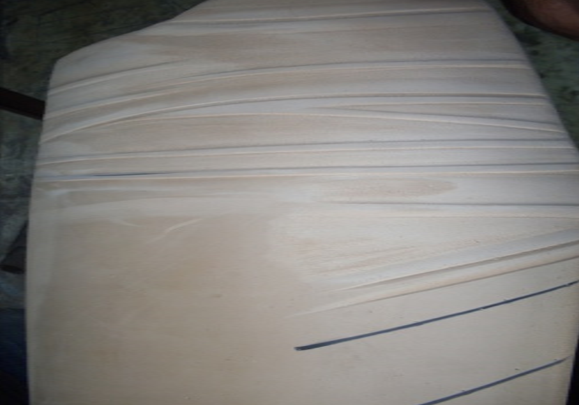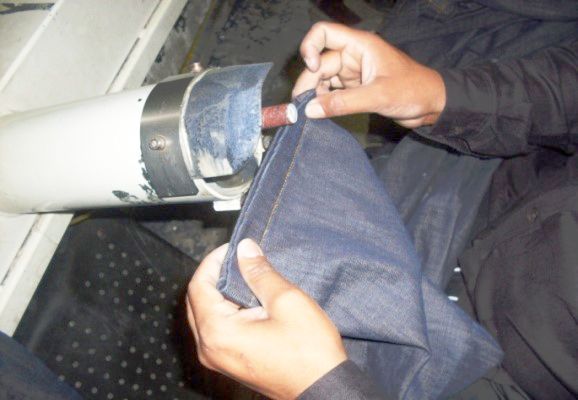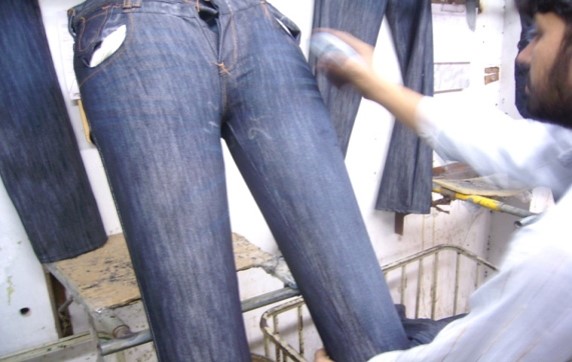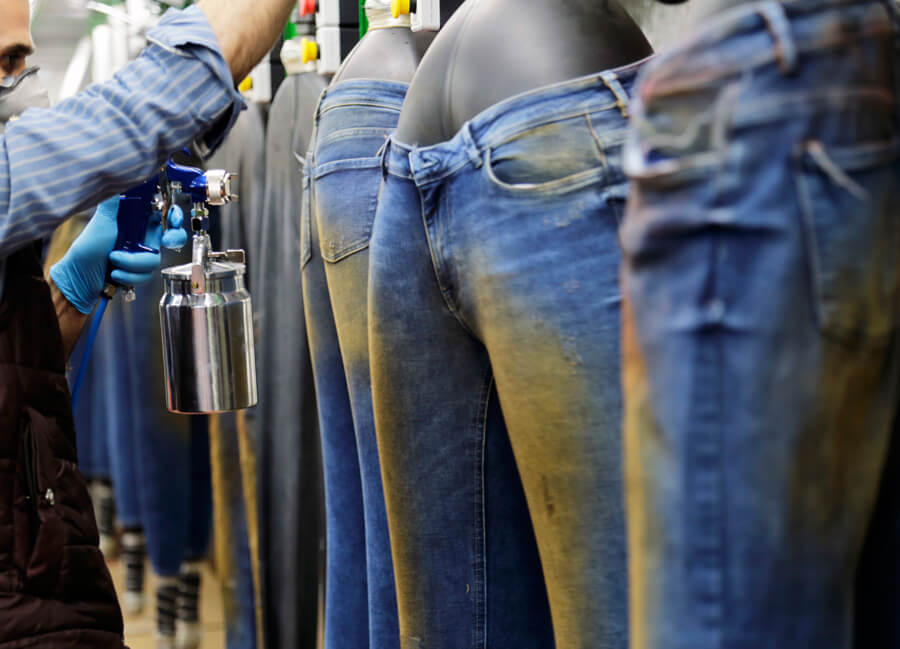These
processes are used
to give rough look or worn look to Denim Products and their proper look can be seen after
washing. These
processes don’t include the use of water hence are called dry processes. These
processes are also called the “Special Effects” as they give a special vintage
look to the garment.
These
processes include the following processes.
- Moustaches/Whiskers
- Scraping
- Grinding
- Destroy
- Tacking
- Tie Effect
- Resin and 3D effect
- Clip Wrinkles (Crinkles)
- Hanger Wrinkles
- KMnO4 Spraying
Whiskers
The word
Whiskers in jeans came from animals who have these stiff, functional hair used by animals to sense their environment. Such type of shape patterns are generated near the crotch area which mimic the creation of whiskers on the surface of the garment. These
are worn
out lines / impressions generated by natural wearing on Back Knee and thigh
area.
These
gives the look and shape of the mustaches on the garments. Its
mechanical process produced by local abrasion without use of chemicals.
This operation requires highly skilled labor who can handle uniformity, hand pressure and sequence in whisker lines.

Whiskers (Photo Credit: D. Umer)
The garment is mounted on balloon manikins or firm surfaces which have pattern design marked on them. With the help of sand/emery paper of different fineness, the abrasion of garment is performed. A
pattern is made according to the required design.

Whiskers Pattern (Photo Credit: D. Umer)
Garment
is put on the pattern and rubbed by the emery paper to produce the required
look. The warp yarns are rubbed and the pattern below the fabric surface appears on the garment surface.
Whiskers (Video: D. Umer)
Scraping
Its
also the process of local abrasion to give a used look to the garments. Its
mostly done on the front
thigh & back seat or
can be on the whole garment. It’s
a mechanical process without the usage of the chemicals/water. The
garment is put on the balloons and rubbed by the emery paper to produce the
local abrasion at the required area.
This operation requires highly skilled labor who can handle uniformity, hand pressure and sequence in whisker lines. Fabric may get damaged during scrapping if care is not taken. During scrapping care is also taken that stitch lines aren't rubbed as it may result in seam failure which is a critical fault. (Unless its a design requirement)
Scrapping (Photo Credit: D. Umer)
Scrapping (Video Credit: D. Umer)
Grinding
This procedure is performed with the help of grinders of various sizes of abrasion paper attached with motors. This task is usually performed with edges like on bottom hem, front pocket, back pocket etc. High-speed motor creates worn-out effect on the edges. In this mechanical process, intense abrasion against the running stone or
hard emery paper damages warps of garments at the edges.

Grinding (Photo Credit: D. Umer)
Grinding (Video Credit: D. Umer)
Destroy
The process of destroy say it all. In this process, the fabric yarns are destroyed on locations as per design pattern. Sometimes the destruction is only for the exposed warp yarns and at times for both warp and weft yarns. This rigorous process create the extreme worn-out effect on the body of the garment. The
destroy is mostly done on the thigh and knee area.
Destroy (Photo Credit: D. Umer)
Destroy (Video Credit: D. Umer)
Tacking
In
this process the garments are tacked or tied with pins or ties to achieve the
contrast look during the washing. The
area tied or tacked remains unwashed and gives an unwashed look and a high
contrast. The
tacking is a mechanical process and is mostly done on the back pockets, front
pockets, and bottom hem area. The
tacking pins and ties need to be cut and removed after washing.
KMnO4 Spray
In this process, the garment is sprayed with the KMnO₄ chemical where the used look is wished. The KMnO₄ is
a chemical with a pink color and gives an abraded look to the garment. The
spray removes the dye from the sprayed area and fades the area giving it a whiter
look. It is
basically chemical abrasion. In
this process the garment is loaded on the balloons and KMnO₄ is sprayed on the garments. This
process is mostly done after the scraping and first wash to achieve a
better look. The
process is done mostly on the front thigh and back knee area to achieve a used
look.
*The KMnO₄ is
hazardous to health and workers need proper protection by using masks, gloves, and safety glasses to avoid any accident or damages. This process is discouraged by the environmentalists due to its extreme bad impacts on worker health, yet it is practiced in many of jeans products. Sand Blasting
This process had been used extensively for denim manufacturing and came under criticism in first decade of 21st century. As the name says that the ‘Sand blasting is a process in which an abrasive material inform of granulate (sand is blasted with high speed on the surface of garments to locally abrade or change the color of the garment. IN this way a. The common blasting materials used are sand and metal granules. Sandblasting is a dry process that involves no water is used for creating a distressed/abraded/used look on garment surface.
Following are the key components of a blasting system.
- A blasting system which is usually air
- blast pot – a pressurized container filled with abrasive blasting media
- A dust collection system that filters the air in the room and prevents particulate matter from escaping
- Material recycling system to collect abrasive blasting granulates to be used again
The sandblasting technique involves removing the dark indigo pigmentation from the garment. Propelling a stream of abrasive material (sand) against the fabric under high pressure gradually softens and lightens the denim. The desired finishing result can be achieved by increasing or decreasing the exposure. Whilst some factories use sealed blasting cabinets with ventilation, others require workers to operate the machinery in treatment rooms. The type of blasting material used can also differ. Certain materials can be reused and others are disposable. In some cases ventilation in the cabinets sucks the blasting material through a filter, so that it can be reused on another item of clothing.
Worker Safety
Statistics from the Occupational Safety and Health as well as from World Health Organisation have confirmed that the aggressive process of sandblasting actually leads to incurable diseases like lung fibrosis, emphysema, and silicosis among factory workers.
Silicosis is caused when small particles of silica dust from the sand embed themselves within the lungs, causing shortness of breath, coughing, weakness, and weight loss. Silicosis is incurable and, in its acute form, fatal. According to reports, Silicosis kills about 100 people every single year.
Sandblasting jeans are
banned in Turkey.






